

By Eric Lindstrom
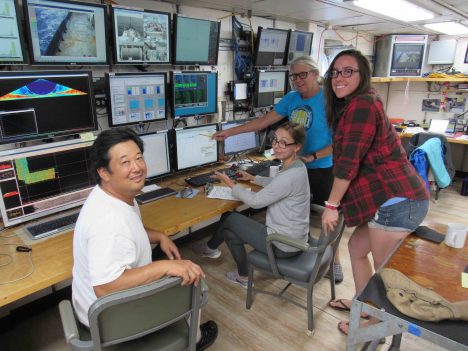
The CTD team (Spencer, Leah, Janet, and Kristin).
The focus of SPURS-2 is the upper ocean and the fate of rainwater. However, in order to study the top of the ocean one needs to know what is going on deeper down. The beauty of SPURS-2 is not skin-deep! SPURS-2, like many prior physical oceanography experiments, requires a basic background and context of the ocean circulation environment upon which many of our other more specialized or detailed measurements can be interpreted. The two major pieces of the contextual information for us are the surface circulation and the surface salinity pattern.
The surface salinity pattern is provided by remote sensing for the largest scale and by the array of drifters and profiling floats that have been deployed with salinity sensors. Also, the R/V Revelle is collecting a treasure trove of upper ocean salinity measurements wherever she goes – with continuous underway measurements of salinity from intakes at the surface, 2 meters (6.5 feet), 3 meters (9.8 feet), and 5 meters (16.4 feet) depths. I’ll go into that in more detail in a later blog on the Surface Salinity Profiler.
The surface circulation of the ocean is largely the result of the wind and the shape of the massive deep layers below the surface. In fact it can be crudely estimated if one knows the precise shape of the thermocline – the boundary between the warm upper ocean and the vast deep cold ocean. Here in the tropics the thermocline is pretty well represented by the 20°C (68° F) isotherm. Think of the warm upper ocean as all the water warmer than 20°C and the layer below as all the water colder than 20°C. Tropical oceanographers can use the depth of the 20°C isotherm much like meteorologists use surface atmospheric pressure maps to chart the highs and lows of weather and their associated winds. Here, if the 20°C isotherm rises toward the surface locally it is associated with a counterclockwise ocean surface current. The signature of the westward North Equatorial Current is a gentle slope of the isotherm from deeper in the north to shallower in the south. This is where our Conductivity-Temperature-Depth (CTD) instrument comes into the SPURS-2 plan. We can use it to track the shape of the thermocline. I wrote about the CTD during the SPURS-1 campaign. It is still the workhorse of physical oceanography – or maybe the monkey on the back of every physical oceanographer! Our show seldom goes on without it.
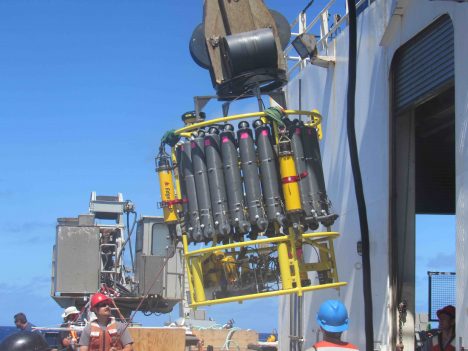
Preparing the CTD to go over the side.
Janet Sprintall from Scripps Institution of Oceanography and her team (Spencer Kawamoto, Leah Trafford, and Kristin Fitzmorris) are now mapping the temperature and salinity structure of the ocean well into the deep cold abyss (to 1.5 kilometers –0.93 miles– below the surface). The ocean depth is about 4.5 kilometers (2.8 miles) and the lower 3 kilometers (1.86 miles) are (for our purposes) relatively uniform and cold. Janet has planned a grid of 49 stations 30 miles apart around the SPURS-2 central mooring. These will be completed over about a week’s time. Simultaneously there will be regular sampling with the Surface Salinity Profiler between some of the CTD stations and we will optimize our meteorological measurements by limiting our speed to 10 knots (11.5 mph). So, while studies of the meteorology and near surface salinity are ongoing, as we move about the ocean, Revelle stops for an hour every 30 miles to collect necessary information on the background oceanographic conditions.
The CTD instrumentation remains largely unchanged (although perfected) in recent decades. Temperature, salinity, and oxygen sensors are mounted on the bottom of a large frame. Water sample bottles are mounted around the outside of the frame. Other instruments, such at the acoustic Doppler current profiler, may also be mounted on the frame. All data is transmitted up the conducting wire cable that is used to raise and lower the instrument. This bulky package is now easier to deploy and recover than in yesteryear due to innovations on today’s vessels. Now the Revelle has a specialized mechanical arm to get the CTD over the side and back on deck safely without much human intervention.
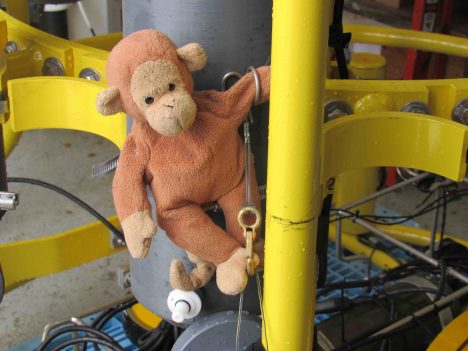
Monkey climbing over the water sample bottles on the CTD.
For my entire career oceanography has been spelled “CTD.” Knowing the temperature and salinity structure from surface to ocean depths is the key to our understanding of the ocean’s role in climate. The first global mapping of these characteristics (with CTDs) was not realized until the World Ocean Circulation Experiment in the 1990’s. Now oceanographers are working hard to understand all the physical, chemical, and biological changes associated with global warming, rising carbon dioxide levels, and industrial fishing. In that big picture, SPURS-2 might look like a small bit of monkey business over the tropical thermocline. However, we know that the resulting scientific understanding will long outlive the memory of our tiny field program in this vast Pacific Ocean!
By Eric Lindstrom

Instruments ready for Lagrangian array deployment at the end of the rainbow.
What do Leonhard Euler (1707-1783) and Joseph-Louis Lagrange (1736-1813) have to do with SPURS-2? How do we have two experiments going on simultaneously honoring the work of these famous mathematicians?
Two frames of reference have taken their names from these 18th century mathematicians. In science, including oceanography, when we make measurements of fluid flows fixed in space, we watch properties such as temperature or salinity as currents carry them by our instruments. This is called an Eulerian frame of reference. However, sometimes we make measurements while following the flow, trying to tag a parcel of water and watch as it moves and changes over time. This water following perspective is called the Lagrangian frame of reference. For example if you watch a river flow past from the bank, you are using an Eulerian frame of reference. If you examine the river from a boat flowing with river, you would be making a Lagrangian observation of the river.
In SPURS-2 we use moorings and a fixed grid of stations to describe a patch of ocean as the water passes by. Moorings, stations, and satellites provide the Eulerian perspective over the year of SPURS-2. We use a variety of drifters, autonomous vehicles, and profilers (instruments embedded in the moving water parcels) to also build an extensive Lagrangian view of the ocean over the year. We use the Lady Amber over the course of the year to service and reset some of the Lagrangian experiment as those assets drift away from the study site. We use the Revelle to deploy the Eulerian array and to seed the ocean with the Lagrangian instruments to be tended at later times by Lady Amber. It really is two experiments united to understand the salinity patterns and movement of freshwater in the ocean!
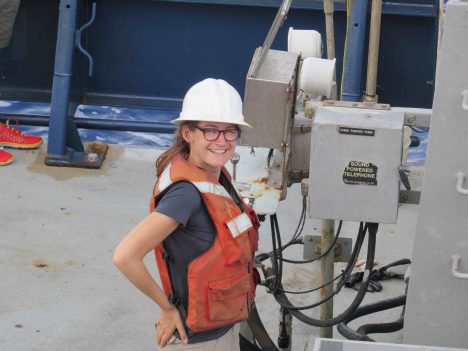
Audrey Hasson driving the A-frame during mooring deployment.
During the Revelle voyage we are also planning a short-term (48-72 hour) Lagrangian experiment capture the processes by which rainwater mixes into the ocean. We will launch drifters specially designed to follow the surface current during a rain event and then follow them for day or two. We will sample the region around the drifters using the Revelle to further examine the changing temperature and salinity properties of the upper ocean. The Revelle will attempt to take several snapshots of the ocean conditions as the Lagrangian array disperses over a day.
Together our Lagrangian and Eulerian sensor arrays constitute a sensor web in the ocean. This sensor web captures ocean motion and salinity changes (particularly) on a wide range of time and space scales. This allows us to analyze processes that lead to changing surface salinity all the way from minutes to seasons and from millimeter size turbulence to major ocean currents. We cannot measure all things we would like all the time and in every place, so we have tuned our effort and sensor web design to provide enough information to estimate what we would like to know. We would like to know about the role of turbulent mixing at the surface; we would like to know the role of eddies in transport of freshwater; and we would like to know how the major equatorial currents impact the eastern tropical Pacific low salinity pool. Obtaining such knowledge of the ocean is ambitious and challenging. SPURS-2 is giving us a shot at providing some unprecedented new knowledge.

Andy Jessup, Chief Scientist on SPURS-2 R/V Revelle.
I would like to give a shout out to our chief scientist on the voyage, Andy Jessup, from the University of Washington Applied Physics Laboratory. Andy has demonstrated extreme patience and diligence to his duty to represent the many investigators working on diverse problems and scales in SPURS-2. He has a team from APL aboard with a complex set of measurements to execute. He balances the time devoted to his own science project and his duties as leader of all the projects represented on the ship. That is not easy and he has found a way to give everyone a voice.
I hope to devote some upcoming blog time to our able CTD crew from Scripps led by Janet Sprintall, the ocean currents in our region in general, and the interaction with the teams back home as seen through the eyes of Audrey Hasson.
Please feel free to send questions and comments on the blog. I’ll do my best to answer all fair questions!

Ben Pietro readies a buoy for deployment.
For SPURS-2 we are installing three moorings that will stay in place for over a year. Our moorings are arrays of instruments dangling from a surface floatation and anchored at the bottom. The moorings eventually will be recovered by R/V Thompson in September or October 2017. They will be recovered by using a release mechanism (acoustically operated) above the anchor.
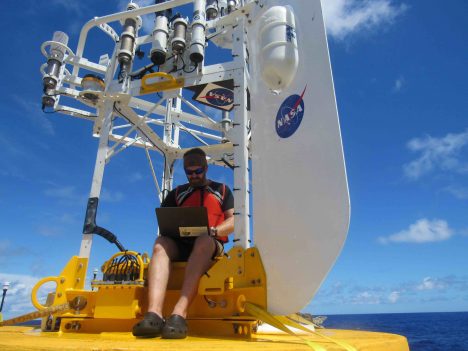
Emerson Hasbrouck, working in his office.
Two of the moorings are supplied by William Kessler at the NOAA Pacific Marine Envionmental Laboratory. They will use the Prawler (profiler + crawler) technology – an instrument system that crawls up and down the mooring wire to sample the upper ocean on a regular basis. This technology has been perfected since SPURS-1. Andrew Meyer and is buddy Monkey are working the deployment of those moorings.
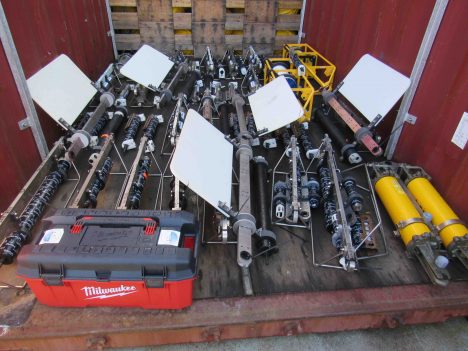
Two instruments, ready for the WHOI mooring.
The SPURS-2 Central Mooring is supplied by Tom Farrar from Woods Hole Oceanographic Institution under a grant from NASA. This mooring is heavily instrumented with temperature, salinity, and current sensors as well as a sophisticated meteorological package at the surface. This gear is the hub around which the rest of the experiment works. It provides the contextual environmental data over then entire year in which other shorter term more intensive measurement campaigns by R/Vs Revelle, Thompson, and Lady Amber will fit.
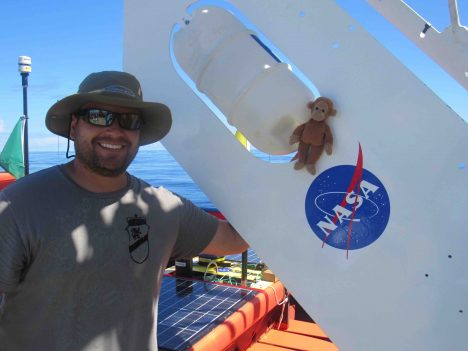
Andrew Meyer and Monkey pose with the SPURS-2 Central Mooring buoy.
Each mooring effectively takes one day of ship time to deploy, since daylight and a morning start is preferred. Each deployment starts with the surface buoy and continues with instruments and line/cable until the release and anchor remain on deck with about 3 miles of mooring strung out behind the ship. If all planning and estimating is correct, the ship will be appropriately positioned with regard to the target site so that the anchor can then be dropped. The ocean bottom – 3 miles down – is relatively flat here at SPURS-2 so precise aiming of the anchor drop zone is not necessary.
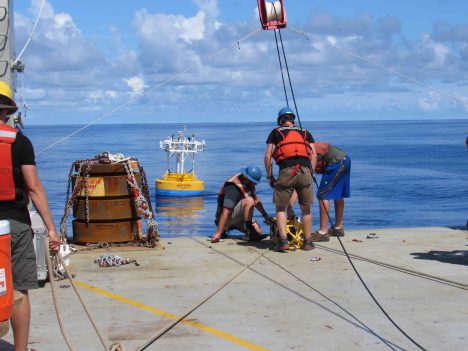
WHOI mooring with anchor.
Deployment of the central mooring in particular is labor intensive and many in the science party contributed to the effort. he deployment effort was orchestrated by Ben Pietro and Emerson Hasbrouck from the mooring group at Woods Hole. Drew Cole and Carmen Greto provided essential expertise as ship’s scientific technical support. Ben and Drew together lead the team through a solid 10 hours of work. Leah Trafford monitored and logged all the equipment as it was deployed. She was ever present with the clipboard and eyes on the instruments. Raymond Graham had a terrific day serving as Ben’s extra pair of hands, handling all manner of assignments with great dexterity.
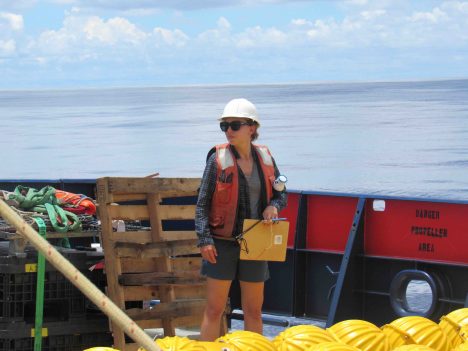
Leah Trafford with the mooring log.
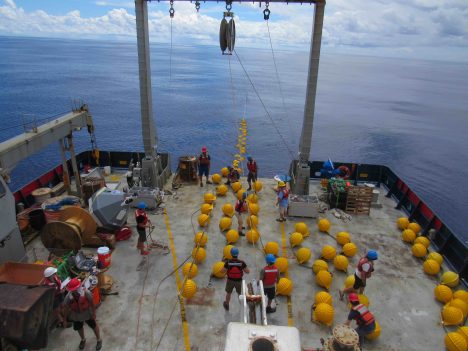
Mooring action on the fantail.
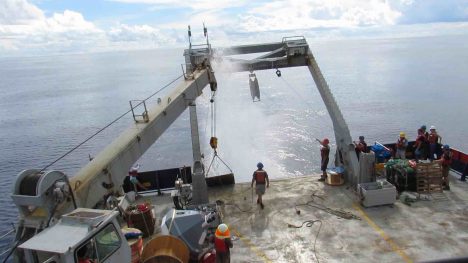
Anchor away for the SPURS-2 Central Mooring.
We’ll spend a full day post-deployment with a variety of projects related to the central mooring. We’ll complete a survey of the site to determine the precise location of the anchor (and acoustic release mechanism). We’ll check meteorological equipment against shipboard measurements. We’ll use a small boat operation to the surface buoy to add additional equipment that could not be launched during the primary operation.
After the second PMEL mooring is deployed, Revelle will be moving to begin mapping of the ocean around the central mooring. A box of approximately 180 miles on a side will be the focus of our sampling for more than a week. There is also a deployment of free-floating sensors. I’ll tell you more in the next post about how we sample the ocean with sensors fixed in space versus those fixed to a water parcel.
Meanwhile, we are enjoying our first serious rainstorm of the voyage at our study location. We hope for many more. If we are going to study how the rainfall mixes into the ocean, we really are hailing the rain dowsers to bring more showers!
Stay dry out there folks, but hope that we get soaked!
By Eric Lindstrom
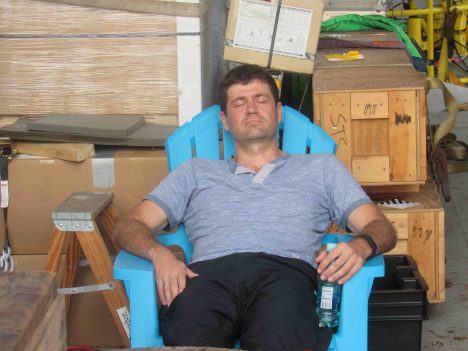
Denis Volkov taking a break from work in the afternoon.
One of the popular topics of conversation during the first week of the voyage has been sleep. Whether it is poor sleep, good sleep, disturbed sleep, or deep sleep, almost everyone in the science party has had something to say about the subject of sleep.
Sleep on a ship is special. As you can imagine, the rocking and rolling (actually pitching, rolling, and yawing) can be a gentle sleep inducement – unless it is making you terribly sick! What those on land probably cannot imagine are all the noises associated with the ship – the engines, equipment, and the sea slapping at the ship. An amazing array of new hums, grinds, bangs, bumps, slams, alarms and conversations must be assimilated into one’s sleep life.
After a week of hard work preparing the ship for sea in Honolulu, it is no surprise that many slept well the first night. However, the next couple days were much harder for some. The mild seasickness and the abnormal noises from the ship unsettled sleeping patterns. More than one person commented to me that their adjustment and best sleep came around day 5. By that time all the seasickness had past and the sounds of being at sea had been incorporated into ones dreams. Soon we will start weeks of 24/7 operations and the luxury of long sleeps may be over until the transit back to Honolulu. Sleep may get interrupted when operations call.

Audrey and Kristen during the early seasick times.
Many scientists will be on 12-hour watches (noon to midnight or midnight to noon) so one should not be too worried out lack of sleep among your favorite scientists. It is more likely that one’s normal rhythm of sleep may be at odds with duties.At sea it is not abnormal to find people eating, sleeping, exercising, and working at odd hours.
Part of writing about sleep now is because (at this writing on Sunday afternoon, August 21) we have completed our transit from Honolulu to 125W longitude and are beginning 24-hour scientific operations with a southbound trek along the meridian. We will be deploying drifters at regular intervals, profiling temperature and salinity while underway, and deploying three moorings along this meridian.
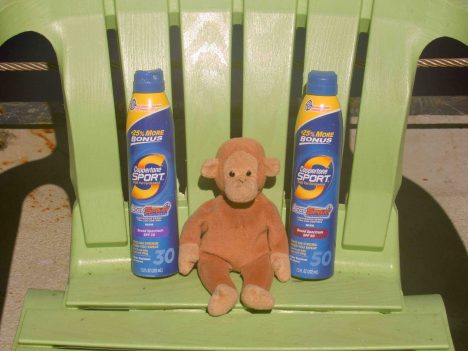
Monkey working on his “monkey tan” at steel beach.
Let me finish today with a little local story about sleep. Andrew Meyer, the mooring technician from the National Oceanic and Atmospheric Administration, has a son, Jack, who is 3 and a half years old. Jack sleeps with his plush toy Monkey every night. When dad left home for the SPURS-2 expedition, Jack sent Monkey along so Andy would not be lonely. So Monkey is having a good time, sending pictures to Jack and family regularly. Monkey is certainly helping Andy keep in touch with his loved ones and that also means that Monkey is helping Andy sleep better at night. So, dear readers, Monkey joins the blog today to honor all that we do to sleep well and to remember those we left at home as we work, and sleep.
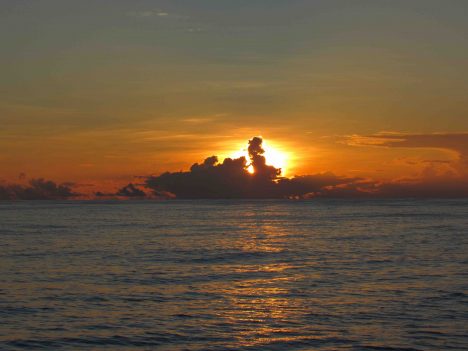
Sunset at sea on Aug. 21.
I leave you today with a sunset and hope that all of you will sleep well!
By Eric Lindstrom
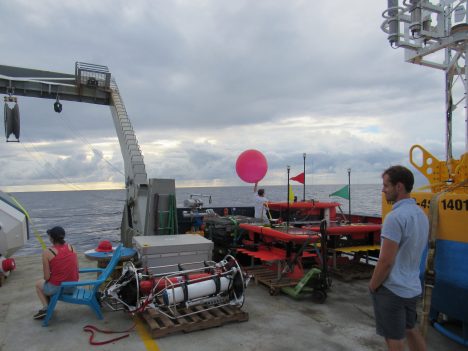
Launching a balloon from the R/V Revellle, for atmospheric sounding.
As I mentioned in a previous blog post, the R/V Revelle is bristling with meteorological sensors. Some are permanently installed aboard, some are just for SPURS-2, and some are on the moorings we will deploy. Raymond Graham, a graduate student at University of Connecticut, did a quick count of meteorological sensors and we were amazed to find out that on a ship of less than 300 feet we had deployed eight wind sensors, 16 air temperature probes, 15 humidity sensors, 15 rain gauges, 11 radiometers, and four barometric pressure sensors! The reason for the overkill is the critical nature of meteorology for our work and the difficulty of obtaining clean data from the ship. Wind and rain especially are notoriously difficult to sample because of flow distortions or shadowing around the ship. By deploying gear at a number of locations (bow, stern, bridge deck, etc.), we will more likely collect clean data no matter which direction the ship is headed relative to the wind. During analysis of the data, one ideal time series of ship data can be assembled from the numerous sensors based on ship heading and true wind direction.

Carol Anne Clayson at work on the bow mast.
For SPURS-2, a group from Woods Hole Oceanographic Institution led by Carol Anne Clayson and a group from University of Connecticut led by Jim Edson are gathering state-of-the-art measurements of key meteorological variables. They will estimate the transfers of heat, freshwater, and momentum between atmosphere and ocean. Today, for example, Jim Edson launched the first of their balloons for atmospheric sounding. The balloon carries a small expendable package that transmits temperature, humidity, and pressure data until the balloon pops in the upper atmosphere.
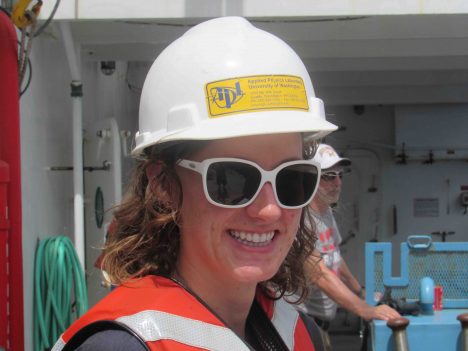
Elizabeth Thompson from the University of Washington’s Applied Physics Lab.
Elizabeth Thompson from the University of Washington’s Applied Physics Laboratory is also working the meteorological angles for SPURS-2 by providing the daily meteorological briefings and analysis of radar data (to help us track rain events). She and Audrey Hasson are providing daily briefings at 4 pm to apprise us of the weather and oceanographic conditions to be encountered over the next day of operations. For the moment they are practicing and perfecting the best information and products to utilize and share. Prediction sure is an activity to sharpen a scientist’s skills!
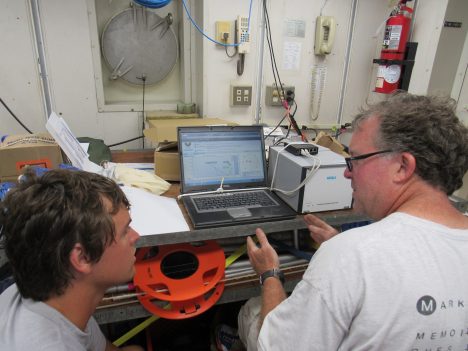
Jim Edson from University of Connecticut and Raymond Graham, a graduate student at U.Conn., looking over the first results from the balloon deployment.
While much of the time aboard Revelle is focused on oceanographic measurements, the meteorology is key to synthesis of the overall story of SPURS. In the end we will want to assess the ocean response to forcing – whether in the form of rain, wind, or sun’s radiation. It is quite difficult to tell the story of the near surface ocean without understanding how it is interacting with the atmosphere. Likewise, it is quite difficult to tell the story of the evolving atmosphere without understanding how it interacts with the ocean. This coupled system is an especially powerful engine for Earth’s climate here in the tropics. The warmer the ocean and atmosphere, the more energy in the form of water vapor is exchanged. Hurricanes are a good example of this interaction and exchange – and a reason to worry about stronger or more frequent hurricanes in a warmer world. Air sea exchange is very sensitive and very powerful when ocean waters are greater than about 83 degrees Fahrenheit (28.5 degrees Celsius) as is found in the deep tropics and here in the Intertropical Convergence Zone.